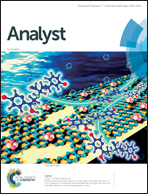Gold-nanostar-based SERS substrates for studying protein aggregation processes†
Abstract
Aggregation of proteins has been related to some neurodegenerative diseases such as Alzheimer's and Parkinson's among others. Raman spectroscopy is a useful technique for the investigation of protein conformation and of changes in their secondary structure. In this study, a surface enhanced Raman spectroscopy (SERS) substrate based on the immobilization of plasmonic gold nanostars on a glass slide via silanization of the surface has been prepared and characterized. Gold nanostars were synthesized via a seed-growth method using gold nanoparticles as seeds obtained via stainless steel as the reducing agent. The plasmonic substrate provided an enhancement of 5.7 × 102 fold, as shown for the Raman signal of crystal violet. Using this SERS-active substrate, the investigation of aggregation processes of bovine serum albumin (BSA) and myoglobin proteins upon temperature and solvent modification has been enabled with enhanced sensitivity. Both curve fitting and deconvolution of the amide I band, as well as 2D correlation analysis, were employed for the evaluation of the changes in the SERS spectra of the protein samples. The amide I band within the SERS spectra of the BSA protein revealed a decrease in the α-helix structures within the secondary structure of the protein while the presence of β-sheet structures increased with temperature and solvent concentration.



 Please wait while we load your content...
Please wait while we load your content...